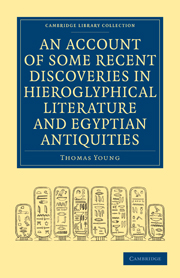 An Account of Some Recent Discoveries in Hieroglyphical Literature and Egyptian Antiquities
An Account of Some Recent Discoveries in Hieroglyphical Literature and Egyptian Antiquities Book contents
- Frontmatter
- Contents
- PREFACE
- WORKS OF THE AUTHOR
- CHAPTER I Introductory Sketch of the Prevalent Opinions respecting Hieroglyphics
- CHAPTER II Investigations founded on the Pillar of Rosetta
- CHAPTER III Additional Inferences, deduced from the Egyptian Manuscripts, and from other Monuments
- CHAPTER IV Collections of the French.—Mr. Drovetti.—Mr. Champollion's Discoveries
- CHAPTER V Illustrations of the Manuscripts brought from Egypt by Mr. Grey
- CHAPTER VI Extracts from Diodorus and Herodotus; relating to Mummies
- CHAPTER VII Extracts from Strabo; Alphabet of Champollion; Hieroglyphical and Enchorial Names
- CHAPTER VIII Chronological History of the Ptolemies, extracted from various Authors
- APPENDIX I Greek text of the Manuscripts and Registries
- APPENDIX II Specimens of Hieroglyphics
CHAPTER I - Introductory Sketch of the Prevalent Opinions respecting Hieroglyphics
Published online by Cambridge University Press: 01 March 2011
- Frontmatter
- Contents
- PREFACE
- WORKS OF THE AUTHOR
- CHAPTER I Introductory Sketch of the Prevalent Opinions respecting Hieroglyphics
- CHAPTER II Investigations founded on the Pillar of Rosetta
- CHAPTER III Additional Inferences, deduced from the Egyptian Manuscripts, and from other Monuments
- CHAPTER IV Collections of the French.—Mr. Drovetti.—Mr. Champollion's Discoveries
- CHAPTER V Illustrations of the Manuscripts brought from Egypt by Mr. Grey
- CHAPTER VI Extracts from Diodorus and Herodotus; relating to Mummies
- CHAPTER VII Extracts from Strabo; Alphabet of Champollion; Hieroglyphical and Enchorial Names
- CHAPTER VIII Chronological History of the Ptolemies, extracted from various Authors
- APPENDIX I Greek text of the Manuscripts and Registries
- APPENDIX II Specimens of Hieroglyphics
Summary
THE Greeks and Romans, either from national pride, or from a want of philological talent, were extremely deficient in their knowledge of all such languages as they called barbarous, and they frequently made up for their ignorance by the positiveness of their assertions, with regard to facts which were created by their own imagination. It was very currently believed, on their authority, not only that Egypt was the parent of all arts and sciences, but that the hieroglyphical inscriptions, on its public monuments, contained a summary of the most important mysteries of nature, and of the most sublime inventions of man: but that the interpretation of these characters had been so studiously concealed by the priests, from the knowledge of the vulgar, and had indeed been so imperfectly understood by themselves, that it was wholly lost and forgotten in the days of the later Roman Emperors. The story, however, of a reward, supposed to have been offered in vain by one of the first of the Caesars, for an interpretation of the inscription on an obelise, then lately brought from Egypt to Rome, appears to rest on no authentic foundation.
Among the works of more modern authors, who had employed themselves in the study of the hieroglyphics, it is difficult to say whether those were the more discouraging, which, like the productions of Father Kircher and the Chevalier Palin, professed to contain explanations of every thing, or which, like the ponderous volume of Zoëga on the Obeliscs, confessed, after collecting all that was really on record, that the sum and substance of the whole amounted absolutely to nothing.
- Type
- Chapter
- Information
- An Account of Some Recent Discoveries in Hieroglyphical Literature and Egyptian AntiquitiesIncluding the Author's Original Alphabet, as Extended by Mr. Champollion, with a Translation of Five Unpublished Greek and Egyptian Manuscripts, pp. 1 - 7Publisher: Cambridge University PressPrint publication year: 2010First published in: 1823


